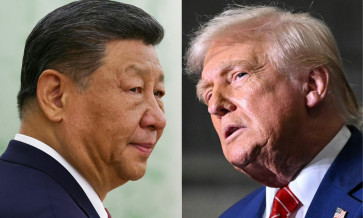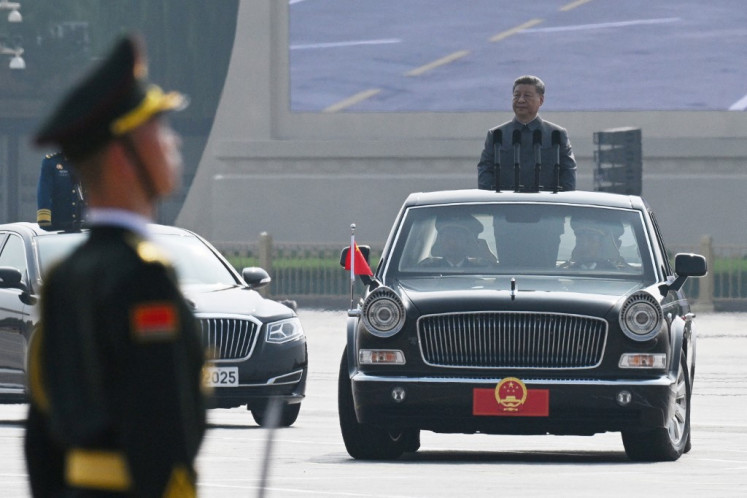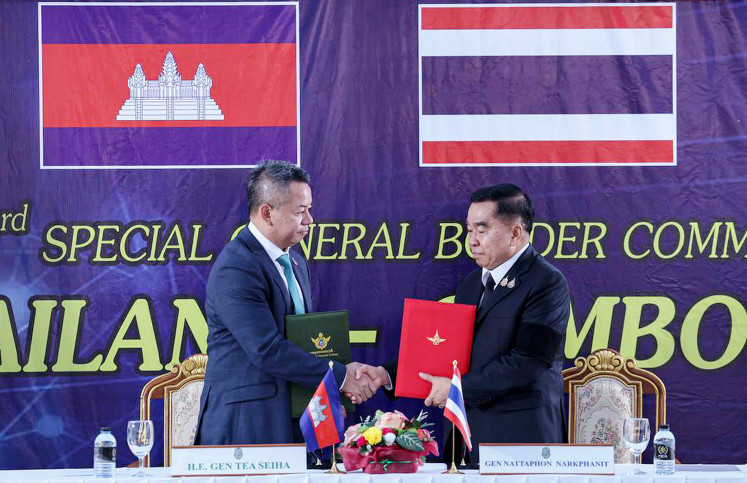Popular Reads
Top Results
Can't find what you're looking for?
View all search resultsPopular Reads
Top Results
Can't find what you're looking for?
View all search resultsThe past, present and future of climate change negotiation
The UNFCCC’s narrow focus on emissions targets has proven ineffective in catalyzing mitigation action compatible with a trajectory for the 1.5-degree target.
Change text size
Gift Premium Articles
to Anyone
T
he 28th global climate summit (COP28) of the United Nations Framework Convention on Climate Change (UNFCCC) has just wrapped up in Dubai, United Arab Emirates.
To date 198 countries, including Indonesia, have ratified the UNFCCC, making it the biggest UN convention in the world.
Consisting of 26 Articles, the UNFCCC is the foundational treaty accepted by the parties. It aims to prevent dangerous human interference with the global climate system. It has become a basis for international climate change negotiations.
Since its establishment in 1992, the UNFCCC has marked three milestones: the Kyoto Protocol (1997), the Bali Road Map (2007) and the Paris Agreement (2015). According to the Kyoto Protocol, reducing greenhouse gas (GHG) emissions is a mandatory obligation for developed countries and a voluntary contribution for developing countries.
However, nearly 20 years after Kyoto took effect, scientists have warned that cutting the emissions by putting the responsibility on the shoulders of developed countries is badly insufficient. This is the main reason why, in the Paris Agreement, all the countries, including developing countries, are obliged to reduce their national GHG emissions. The Bali Road Map, on the other hand, paved the way for future climate solutions, which are reflected in the Paris Agreement commitments and beyond.
The UAE Consensus, the agreement out of COP28, marked another historic milestone in global climate negotiations. Now, almost every nation has agreed to transition away from fossil fuels, the primary driver of climate change, to accelerate and achieve net-zero emission by 2050, keeping 1.5 degrees Celsius within reach, as suggested by scientists.
Tripling renewable energy capacity, doubling energy efficiency, phasing down coal power plants and decarbonizing the transportation sector are among the agreed upon details from the plan to move away from fossils.
When the UNFCCC took effect in 1994, there was less scientific evidence than there is now. The UNFCCC borrowed an important line from one of the successful multilateral environmental treaties of the time, the Montreal Protocol of 1987.
Accordingly, the UNFCCC formed the Intergovernmental Panel on Climate Change (IPCC) to provide scientific evidence and develop recommended mitigation and adaptation measures for policymakers. However, the IPCC recommendations have not been fully considered in reaching the agreements. Only in the COP27 in Glasgow in 2021 did the parties agree to use scientific reports as the basis for making COP decisions.
Structural problems within the UNFCCC have limited its effectiveness in mandating climate change mitigation actions, particularly on the level of the nation-state, where its primary focus lies. Additionally, the COP negotiators come from state actors who may leave office every four to five years, and new ones come afterward.
This has been an impediment, as climate change is a long-term issue. Often, the replacement of government officials brings about limitations to the capacity and capability of negotiators and may result in the country's position in climate negotiations becoming inconsistent, incoherent and unsustainable if negotiators change with the change of governments.
The involvement of the private sector, nongovernmental organizations (NGOs) and academia is only at the beginning stage of recognizing climate action by non-state actors. Climate mitigation and adaptation actions from non-state actors are urgently required. Additionally, subnational governments, cities, corporations and NGOs have significant potential in enhancing national efforts to curb carbon dioxide emissions between current commitments and the action necessary to meet climate targets.
Concerning financial issues, it can be said that current climate financing is inefficient, insufficient and unfair. With the already soaring debt levels and borrowing costs, climate action must be funded through more equity investments and concessional financing.
Industrialized nations have agreed under the convention to support climate change activities in developing countries by providing financial support for climate action. However, commitments and promises are not complete without implementation.
Industrialized countries promised to provide US$100 billion annually to undertake climate actions in developing countries. Unfortunately, 14 years after the pledge was made, this promise never became a reality.
The UNFCCC’s narrow focus on emissions targets has proven ineffective in catalyzing mitigation action compatible with a trajectory of the 1.5-degree target. In addition, the static division of industrialized and developing countries, i.e. Annex-1 and Non Annex-1 countries, and the consensus-based decision-making rules have impeded ambitious climate action. The UNFCCC is much better equipped to provide rules for climate protection activities and should consciously expand this feature to improve its impact.
Building upon our observation and discussion with eminent persons during COP28, there are at least three reflections on bridging the gap between global climate negotiations and climate action.
First, we need to advance the concept of collective efforts and realize actual climate actions. Some of the emerging ideas around this proposition are to focus on the collective long-term strategy while translating it into short-term commitment under the Nationally Determined Contributions (NDCs); to establish a regionalized strategy and technology-based approach in accelerating concrete climate actions at the national and subnational level; to build a conducive global financial architecture to enable the required financial mobilization works; and to test and implement a breakthrough model to fund the financial capital for climate transition.
Second, we need to tweak the current COP model and its mechanism. Tweaking the current COP could mean alternating between big and small COPs, with “mini” COPs that either come with the thematic or regional approach in between. By doing so, a more cohesive regional COP event could be organized to relieve the annual mega-conference audiences.
Another means of this could be copying the tri-party involvement in the COP presidency from the previous, current and future as we did in the Group of 20 and ASEAN chairmanship.
Third, we need to acknowledge and incorporate the pivotal role and support from non-state actors into formal COP negotiations. In many cases, there are great deals, pledges or collaboration agreements during the COP between non-state actors in raising climate actions, not only ambitions, yet they are not being “incorporated” into the formal follow-up of the negotiation outcomes.
Another rationale for how vital non-state actors are is that they often “safeguard” the state actors, which usually have vested interests and political changes every three to five years, depending on countries’ constitutions.
To wrap up, we should seize this development at COP28 to redefine the future of COPs. Together, as state and non-state actors, a new framework can be developed that is not only ambitious but also resilient and adaptable. It is our collective responsibility to shape a future where the world stands united against the challenges of climate change, fostering a sustainable, just and inclusive global community.
***
Rachmat Witoelar is former environment minister and the UNFCCC COP13 president (2007). Doddy S Sukadri is executive director of Yayasan Mitra Hijau, Jannata Giwangkara is senior project manager at Climateworks Center, Australia.











